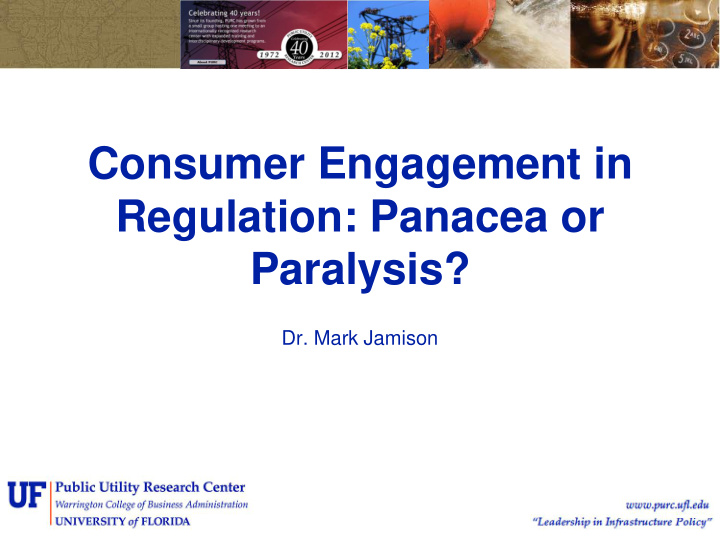



Consumer Engagement in Regulation: Panacea or Paralysis? Dr. Mark Jamison 1
Consumer Engagement in Context • Purpose of regulation and agency – Public interest: Control market power • Must serve; Limit rent extraction – Rent seeking • Powerful groups (including the regulated) seek benefits through regulation – Taxation by regulation • Politics seeks resources – Limit information asymmetry and political opportunism 2
Consumer Engagement in Context • Regulatory process in U.S. – Appears quasi judicial • Statements of law, findings of fact, decision – Substantively quasi legislative • Initiates own proceedings; develops own record • Investigative powers – Led by executive branch “appointees” 3
Purposes of Consumer Engagement • Integrity and legitimacy of system – Information for regulator – Combat corruption and favoritism – Educates public – Gives consumer voice (due process) – Facilitates buy-in • Consumer protection (but could be done by others) 4
Consumer Engagement in U.S. • Transparency – In some states, anyone can watch everything the regulator does • Sunshine laws; broadcasts of meetings; notice of activities; open records – Federal is less transparent • Open records • Decisions in private; ex parte 5
Consumer Engagement in U.S. • Public communications – Workshops, etc. specifically with public • Consumer complaints – Consumer protection • First option: Utility resolves – Protects and educates consumers 6
What’s The Problem? • Sometimes inhibits adaptive work – Public discussion inhibits open dialogue • Who speaks for consumer? • Are we protecting consumers from reality? 7
Dual entitlement • Consumers believe – Entitled to reference transaction, e.g., what others paid – Firms entitled to reference profit • Examples – Consumers: Locked phones in Hong Kong – Politicians: OECD broadband benchmarking; Windfall profits tax 8
Consumer choice theory • Two separate utilities – Acquisition utility (V A ) • Value of owning the product – Transaction utility (V T ) • Fairness of the exchange • Net consumer surplus = V A + V T - P 9
Transaction utility • Increased by – Paying same as others – “Cost - based” pricing – Getting a “deal” • Decreased by – Others getting a better deal – “Unjustified” price differentials – “Unfair” treatment of workers 10
Norms • Customers form expectations • Expectations change if an unusual practice becomes common – Data caps become more accepted over time – Real-time pricing 11
Meaning for regulators • Examples where customers complain when norms are broken – Unlocked phones – Regulation of landline telecoms – Methods of paying bills – Feed-in tariffs – Extended area service 12
Meaning for regulators • Should regulators require operators to follow norms? – For example, by disallowing versioning that is seen as unfair • Should regulators encourage operators to break norms? – For example, by not siding with customers 13
Conclusions • Danger that consumer engagement is overrated – Paralyzes process and progress? • Danger that consumer engagement is taken too lightly – Engage in serious discussion? 14
• Consumer engagement in the past has been largely about transparency, information and consumer protection – Served a static world • Next practice: Stirring and steering – Serves a dynamic world with no easy answers 15
Recommend
More recommend